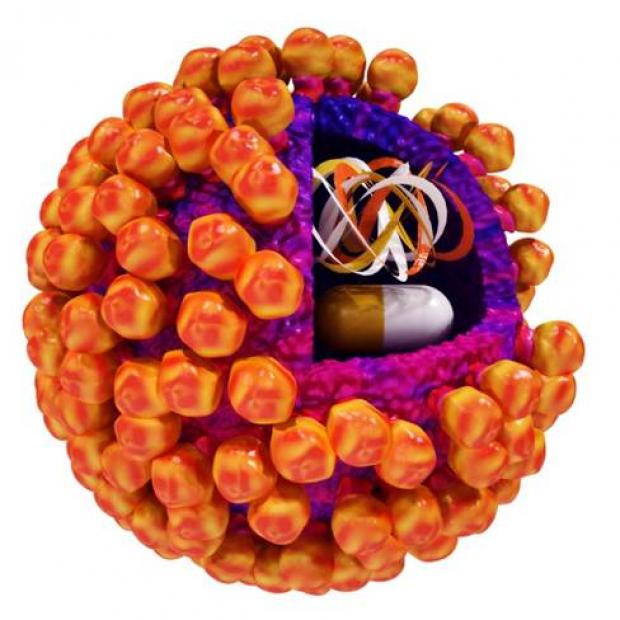
VLPs: Virus Like Particles are an interesting vaccine concept, they are indistinguishable from viruses yet as only the external shell, no infectious agent is associated. This has thus become a new concept in the effort to protect against viruses.
These peculiar particles are designated the new trojan horses of vaccine development. Both human and animal immune systems will recognise these VLPs as what they perceive to be a virus providing an immune response to fight back….but it is just the shell! VLP’s do not contain any genetic information that makes the animal or human ill.
Their elegant, repetitive protein structures mimic the structure of viruses but lack the genetic coding to make them a dangerous infectious virus.
Other vaccine strategies are often viruses that have been attenuated – they have been altered which mean the virus is not infectious or going to cause ill effects; or they are killed – and have the infectious/virulent properties removed. However as VLP’s are just the shell of the virus – no infectious/virulent properties attenuated or killed are associated with these structures at all.
The makings of a great vaccine?
VLPs are very safe vaccine candidates as no infectious viral genome is found within VLPs and they are unable to replicate. Take for instance the oral polio vaccine- a live attenuated vaccine, it has recently been found that the oral polio vaccine can revert back to it's viral form causing vaccine-associated paralysis. VLPs have no genetic material to be able to do this, providing an excellent safety characteristic.
Compared to many other vaccines they have a higher stability in extreme environmental conditions, where before there may be temperature sensitive and thus be inactivated at a certain temperature.
VLPs can activate the immune system in a number of ways making it efficient and enabling a robust immune response at higher achievable levels. VLP’s encode patterns (PAMPs: Pathogen associated molecular patterns) that are recognised by immune system receptors (Pathogen recognition receptors), different patterns activate different receptors which activate different immune responses, enabling that efficient, robust response.
VLPs are multivalent: they are able to defend against one virus due to their VLP structures but they can also be a carrier of other foreign structures that can protect against other viruses.
Lower doses of VLPs are needed compared to other vaccines to achieve the same level of response. This is of special benefit to livestock owners, who must weigh up the cost of vaccinating their animals with making an economic return on the animals.
A further interesting point, is that VLPs can not only be used for infectious disease but also therapeutically, by acting as a carrier to supply essential parts of the immune response that an animal may be lacking in.
VLPs DIVAs….
What is very important in veterinary medicine is being able to differentiate between infected and vaccinated animals: DIVA. Often the immune response respond in the same way (antibodies) to both the microbe and the vaccine, meaning that when testing is done, infected cannot be differentiated from a vaccinated animal. This is often the case for live attenuated and killed vaccines.
The content of VLPs allows surveillance to differentiate between infected and vaccinated, highlighting VLP Vaccine’s DIVA capabilities.
Success stories
Human VLP based vaccines have been developed and licensed for hepatitis B and Human Papilloma Virus proving successful stories. Whilst the only licenced animal VLP based vaccine to date is the pig Circovirus type 2 VLP vaccine (Porcilis). Circovirus is a multisystemic wasting syndrome which causes symptoms including diarrhea, wasting, weight loss and respiratory stress.
A recent success in multivalent VLP research is the development of what is known as a chimeric swine Influenza- PRRS VLP. The VLP repetitive protein structure targets influenza whilst the VLP is also a carrier of a non-infectious part of the Porcine Reproductive and Respiratory Syndrome Virus incorporated inside. This VLP therefore can tackle two viruses simultaneously, which is of particular use for swine influenza and PRRS as they often infect pigs simultaneously.
VLP developments: A Foot and Mouth VLP Vaccine
One strong contender for animal VLP vaccines is for the Foot and Mouth Virus. Foot and Mouth is the most economically important infectious disease of livestock globally. As there are several different types of FMD (serotypes), this makes it hard for vaccines to work on all of them as they are all slightly different and thus, for each different type, the vaccine needs to be slightly different. The vaccines are also unstable in certain environments and can have an effect on how well the vaccine actually works when administered (vaccine efficacy).
VLPs are a strong contender to help solve these problems as well as several others. As the VLP is made up of conserved protein structures seen in all types of FMD viruses, this enables broad acting vaccine strategy. At present, Foot and Mouth vaccine experiments must be done in high containment facilities due to the disease being incredibly infectious. As VLPs do not contain any genetic information, these could be produced under less stringent facilities and manufactured at a much easier and efficient cost. Cost is of particular consequence as many developing countries are endemic with FMD therefore the cheaper the costs of producing, scaling out and opportunity for farmers to buy, will be must easier as well as have the capacity to be made in these countries.
The future for VLPs is looking promising with many applications in animal and human vaccines in the pipeline. The VLP strategy shows encouraging potential as an ideal vaccine, a Trojan horse to win against the war on disease.
Picture taken from: Crisci et al. “Virus-like particles: the new frontier of vaccines for animal virual infections”, Vet. Immunol. and Immunopath., 2012
